By Desis, for Desis and Everyone Else!!
What’s a Desi?
The term “desi” is a term that is commonly used by people from the Indian subcontinent to refer to themselves or other people (origin or ancestry) from the region.
The word “Desi” is derived from the Sanskrit word “desh,” which means “country” or “region” or “homeland”. (‘Sanskrit’ word ‘Desh’? What is Sanskrit?)
Did you ever wonder:
What is Indian culture like? Learn more!
Interesting facts about India you didn’t know about!
Explore Indian customs.
Traveling to India? You are in for a treat – Explore here!
Here are a few articles from this site – use the menu at the very top of this page to discover many more…
Desi people can come from countries such as India, Pakistan, Bangladesh, Nepal, Sri Lanka, Bhutan, and Maldives. The term can also be used to describe aspects of Indian origin culture, including food, clothing, music, and art.
Karma is a what?
Karma is a term often heard in popular culture, typically associated with the idea that “what goes around, comes around.” But where does this word originate, and what does it truly mean? Let’s explore the depth and significance of Karma in Indian philosophy.
Summary

Source – Karma symbols such as the endless knot (above) are common cultural motifs in Asia. Endless knots symbolize interlinking of cause and effect, a karmic cycle that continues eternally.
Karma is the belief that actions have consequences. In India, every action, thought, and word is believed to generate karma, which can be positive or negative. This accumulated karma affects an individual’s future experiences, including their next birth. Spiritual practice aims to perform actions that generate positive karma, leading to liberation from the cycle of samsara (the cycle of birth and rebirth). Understanding Karma encourages us to cultivate virtues, foster personal growth, and live with integrity, knowing our actions today can plant the seeds for a brighter future.
What is Karma?
Karma, derived from the Sanskrit word meaning “action” or “deed,” forms a cornerstone of Indian philosophical systems such as Hinduism, Jainism, and Buddhism. It embodies the idea that every action, intention, and thought leaves an imprint on an individual’s life, influencing their present circumstances and shaping their future.
The Law of Cause and Effect
Karma operates on the principle of cause and effect, asserting that every action carries consequences both in this lifetime and in future rebirths. This concept suggests that individuals are not mere recipients of fate but active participants in their life’s unfolding. Like ripples from a stone thrown into a pond, Karma’s effects resonate throughout one’s existence, influencing their experiences and even the nature of subsequent rebirths.
Karma in Different Philosophies
Karma in India
In Indian philosophies, Karma is closely linked with the concepts of Dharma (duty and so much more) and Samsara (the cycle of birth and rebirth). Good deeds aligned with one’s Dharma generate positive Karma, leading to favorable outcomes and spiritual growth. The accumulated Karma from past actions influences one’s current life, impacting health, social status, and the joys or sorrows encountered.
Karma in Jainism
Jainism emphasizes Karma’s impact on the soul’s journey towards liberation. Karma is viewed as a subtle force binding the soul, perpetuating the cycle of birth and death. Adherents of Jainism strive to cultivate right conduct, moral purity, and spiritual discipline to gradually free themselves from karmic bondage.
Karma in Buddhism
In Buddhism, Karma is also linked to the cycle of Samsara but emphasizes the intention behind actions rather than the actions themselves. The quality of one’s intention, driven by ignorance, aversion, or wisdom, determines the karmic consequences. Buddhism teaches that by developing mindfulness, wisdom, and compassion, individuals can transform their intentions and cultivate positive Karma that leads to liberation from suffering.
Practical Implications of Karma
Karma Simplified
Imagine Karma as a gentle breeze carrying the echoes of your actions throughout existence. It’s like a cosmic boomerang reminding us that every action, intention, and thought has consequences. Just as seeds sown in a garden bear fruit in time, Karma suggests that our actions, whether loving or harmful, shape our future experiences. This principle teaches us that we are active participants in the dance of cause and effect, with our choices influencing both our present circumstances and future trajectory.
Cultivating Positive Karma
To generate positive Karma, individuals should focus on actions promoting love, generosity, and compassion. Mindfulness practices help in making conscious choices leading to beneficial outcomes. Living with integrity and cultivating virtues like kindness and honesty align one’s actions with positive Karma, fostering personal growth and spiritual evolution.
Personal Responsibility and Growth
Karma underscores personal responsibility. By understanding the consequences of actions, individuals are encouraged to make ethical choices, fostering personal and spiritual growth. This knowledge encourages mindfulness of thoughts, words, and deeds, urging the cultivation of kindness, compassion, and positive intentions. By doing so, we create a harmonious symphony in our lives, bringing joy, fulfillment, and favorable circumstances.
From the Brihadaranyaka Upanishad
Now as a man is like this or like that,according as he acts and according as he behaves, so will he be;
A man of good acts will become good, a man of bad acts, bad;
He becomes pure by pure deeds, bad by bad deeds;
And here they say that a person consists of desires,and as is his desire, so is his will;
And as is his will, so is his deed;and whatever deed he does, that he will reap.
Brihadaranyaka Upanishad, 7th century BCE [19][note 1]
Karma Across Lifetimes
Karma Beyond This Life
The concept of Karma suggests that the consequences of our actions transcend a single lifetime. Imagine Karma as a river flowing through time, carrying the imprints of our thoughts, intentions, and deeds. This belief connects our past, present, and future existences, weaving them into a tapestry of cause and effect. The quality of our actions leaves a mark on our souls, shaping the circumstances and experiences of future lives.
Influence on Future Rebirths
If we engage in virtuous and compassionate actions, these positive energies influence the direction and quality of future experiences. Conversely, harmful actions may manifest as challenges or difficulties in subsequent lives. However, Karma is not deterministic; we have the power to shape our present and future through current choices and intentions. This concept invites us to embrace personal responsibility and strive for positive change, knowing our actions can shape our journey.
Misconceptions about Karma
- Karma is Immediate: While some effects are instant, others manifest over time.
- Karma is Punitive: Karma is a neutral law of cause and effect, not a system of punishment.
- Karma is Predetermined: Individuals can influence their Karma through present actions.
- Karma is Exclusive to Eastern Religions: Similar concepts exist in many philosophical and religious traditions.
FAQs about Karma
- What is Karma? Karma is the principle that every action, thought, and intention has consequences affecting one’s present and future lives.
- How does Karma influence our lives? Karma shapes our experiences, health, social status, and relationships based on our actions.
- Can Karma change? Yes, by making conscious, positive choices and actions, individuals can transform their Karma.
- Does Karma only affect the individual? While primarily influencing the individual, Karma can also impact others through interactions and relationships.
- How can one generate positive Karma? By practicing mindfulness, compassion, ethical living, and engaging in positive actions.
- What is the ultimate goal related to Karma? The ultimate goal is to achieve liberation from the cycle of rebirth (Samsara) through understanding and transforming Karma.
Conclusion
Karma teaches us that our actions, thoughts, and intentions have profound effects on our lives and future rebirths. By understanding and applying the principles of Karma, we can cultivate a life of virtue, integrity, and personal growth, ultimately striving for liberation from the cycle of Samsara.
Every action we take today shapes our future. Let the awareness of Karma guide you towards a path of conscious living and positive transformation.
Glossary of Terms Used:
- Upanishad: A collection of ancient Sanskrit texts that contain some of the central philosophical concepts and ideas of Hinduism.
- Samsara: The cycle of death and rebirth to which life in the material world is bound.
What is Namaste?
What is Namaste? Understanding the Traditional Indian Greeting
“Namaste” is a greeting commonly used in India and Nepal, which is derived from the Sanskrit language.
Namaste is a greeting commonly used in India and Nepal, derived from the Sanskrit language. This gesture, performed by pressing the palms together and bowing slightly, signifies respect and reverence. It symbolizes the belief that there is a divine spark within each of us. Namaste is not just a form of greeting but a way of expressing respect to others, humility, affection, and connection.
Why do people say Namaste? Cultural Significance and Usage
People say Namaste as a sign of respect and greeting, acknowledging the divine within each person. It is used in both formal and informal settings, often accompanied by a slight bow. The gesture fosters a sense of unity and spiritual connection, transcending cultural and religious boundaries. In yoga and meditation practices, Namaste is a way to express gratitude and respect to oneself and others.

The Traditional Way to Say Namaste: Steps and Meanings
It is often accompanied by a slight bow or placing the palms of the hands together in front of the chest, fingers pointing upwards, with the thumbs touching the sternum.
The traditional way to say Namaste involves pressing the palms together in a prayer-like gesture, with fingers pointing upwards, and bowing slightly. This gesture is accompanied by the spoken word “Namaste.” The bow signifies respect and humility towards the other person.

This gesture is called “anjali mudra” or “pranamasana,” and it is believed to represent the joining of the left and right sides of the body, which symbolizes the union of the individual self with the divine.
Namaste has a cultural significance in India and Nepal, where it is commonly used as a respectful greeting in both formal and informal settings.
It is also a way to acknowledge the divine within the person being greeted and to promote a sense of humility and the sense of connection between the two.
There are similar customary greetings in other cultures. For example, in Japan, people commonly bow as a sign of respect when greeting others, and in Thailand, people place their hands together in a prayer-like gesture and bow slightly as a sign of respect. In many Western cultures, shaking hands is a common way to greet others, and hugging is also becoming more popular.
Namaste: Meaning and Spiritual Interpretation
Namaste is a greeting used in many cultures, but it originally comes from Sanskrit. It’s actually two words put together:
- Namah (pronounced nuh-MAH) which means “bow” or “show respect”
- Te (pronounced teh) which means “to you”
So literally, namaste means “I bow to you.”
But it’s not just a physical bow. It expresses a deeper respect and acknowledges the divine presence in both the person greeting and the person being greeted.
“The Divine within me bows to the same Divine within you.”
In spiritual contexts, Namaste recognizes the interconnectedness of all beings and the shared sacredness of life. The term encapsulates the essence of unity, peace, and mutual respect.

Namaskar: Meaning and Difference from Namaste
Namaskar is another traditional Indian greeting, often used interchangeably with Namaste. It carries a similar meaning, denoting respect and reverence.
While Namaste is more commonly used in everyday interactions, Namaskar is considered slightly more formal and is often used in religious and ceremonial contexts. Both greetings reflect the same underlying principles of recognizing and honoring the divine within each person.
Namaskar is a respectful greeting or parting salutation in Hindu and yogic traditions. The word is derived from the Sanskrit base namaha, which means “not me” and refers to bowing in reverence.
How is Namaskar Different from Namaste?
Namaskar is sometimes considered a synonym of namaste, but there are subtle differences in their meanings.
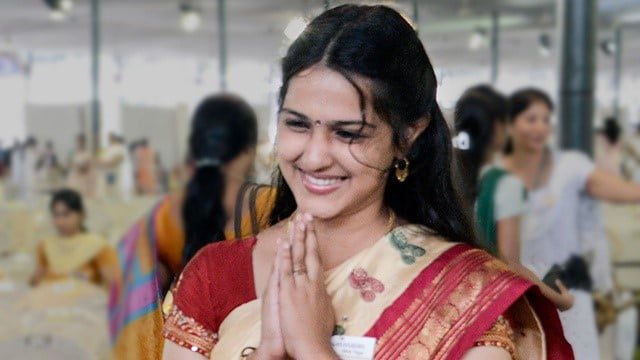
Namaste is the more popular and informal term, meaning “salutations to you” or “I bow to you with respect”, while namaskar is more formal and translates as “I pay my salutations”.
Namaskar is composed of three Sanskrit words:
- Nam, which means “to bow to”
- As, which means “to be” or “to exist”
- Kar, which means “doing” or “one who does”
Namaskar, therefore, is sometimes translated as “I do the act of bowing with reverence.”
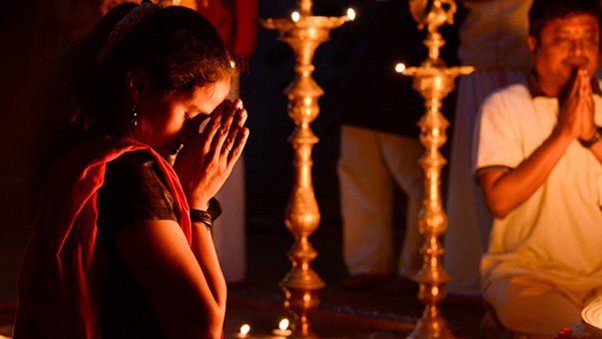
Regional Variations of Namaste and Namaskar in India
Despite these regional differences, the underlying principle of respect and reverence remains the same. These variations highlight the rich cultural diversity of India while maintaining the core essence of the greeting.
Here are a few examples of how people say “Namaste” or “Namaskar” in different Indian languages:
- Hindi: नमस्ते (Namaste) – This is the standard greeting in Hindi and is widely used across India.
- Marathi: नमस्कार (Namaskar) – This is the standard greeting in Marathi, which is spoken in the state of Maharashtra.
- Bengali: নমস্কার (Nomoshkar) – This is the standard greeting in Bengali, which is spoken in the eastern region of India, including the state of West Bengal.
- Tamil: வணக்கம் (Vanakkam) – This is the standard greeting in Tamil, which is spoken in the southern state of Tamil Nadu.
- Telugu: నమస్కారం (Namaskaram) – This is the standard greeting in Telugu, which is spoken in the southern state of Andhra Pradesh.
- Kannada: ನಮಸ್ಕಾರ (Namaskara) – This is the standard greeting in Kannada, which is spoken in the southern state of Karnataka.
- Gujarati: નમસ્તે (Namaste) – This is the standard greeting in Gujarati, which is spoken in the western state of Gujarat.
- Punjabi: ਸਤ ਸ੍ਰੀ ਅਕਾਲ (Sat Sri Akal) – This is a traditional greeting in Punjabi, which is spoken in the northern state of Punjab. It means “Truth is the ultimate reality.”
Learn More about languages from India
It’s worth noting that there may be regional variations in how people say “Namaste” or “Namaskar” in different parts of India, and there may be additional greetings or expressions used in different contexts or situations.
The Origins of Namaste
Namaste traces its roots back to ancient Indian texts like the Vedas and Upanishads, where it was used as a respectful greeting among sages and scholars. Over time, it became an integral part of Indian culture, symbolizing the recognition of the divine spark within each individual. The gesture and the word itself have evolved to represent a universal symbol of peace and respect.
The Significance of Namaste in Yoga
In yoga practice, Namaste is used to express gratitude and respect to oneself and others. It is commonly used at the beginning and end of a yoga session, fostering a sense of community and shared spiritual practice. The gesture helps center the mind and body, preparing practitioners for deeper meditation and self-awareness.
Glossary of Terms
- Namaste: A traditional Indian greeting meaning “I bow to you,” symbolizing respect and acknowledgment of the divine within each person.
- Namaskar: A more formal version of Namaste, often used in religious and ceremonial contexts.
- Yuj: A Sanskrit root word meaning “to yoke” or “to unite,” from which the word “yoga” is derived.
- Upanishads: Ancient Indian texts that form the philosophical basis of Hinduism and discuss the nature of reality and the self.
- Vedas: The oldest sacred texts of Hinduism, containing hymns, philosophy, and guidance on ritual.
Traditional Greetings Elsewhere
Here are a few examples of greetings similar to “Namaste” from around the world:

Thailand: สวัสดี (Sawatdee) – This is a common greeting in Thai, which is spoken in Thailand. It’s often accompanied by a wai, which is a gesture where the hands are placed together in a prayer-like position and raised to the chest or forehead. Source

Japan: こんにちは (Konnichiwa) – This is a common greeting in Japanese, which is spoken in Japan. It’s often accompanied by a bow, which can range from a slight nod of the head to a deeper bow depending on the formality of the situation.

Indonesia and Malaysia: Salam (Salam sejahtera in Malaysia) – “Salam” means “peace” in Arabic, and it’s used as a greeting in both Indonesia and Malaysia.


It’s often accompanied by a handshake, a bow, or the touching of hands to the chest. Source for images
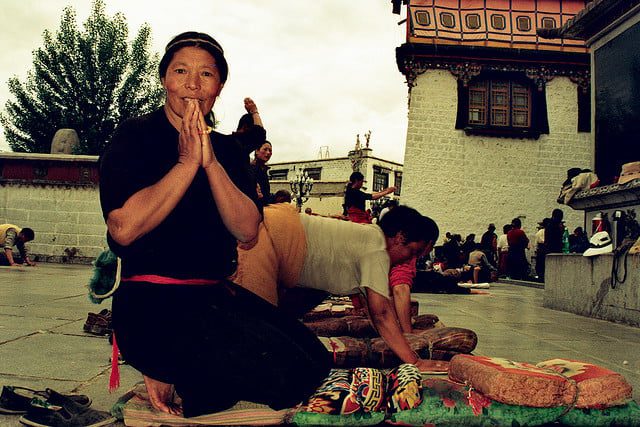
Tibet: Tashi delek – This is a Tibetan greeting that means “auspicious blessings” or “good luck.” It’s often accompanied by a slight bow or putting the hands together in a prayer-like position.

Philippines: Mabuhay – This is a common greeting in Tagalog, which is spoken in the Philippines. It means “long life” or “welcome” and is often accompanied by a handshake or a slight bow.
What are Yoga and Meditation?
Yoga is an ancient spiritual practice that originated in India over 5,000 years ago. The word “yoga” comes from the Sanskrit word “yuj,” which means to yoke or unite, often translated as “union” or “harmony.”
Summary
Yoga is a holistic practice involving physical postures, breath control, meditation, and ethical principles aimed at achieving a state of balance and harmony in the body, mind, and spirit. Originating in India over 5,000 years ago, yoga has evolved through various traditions and texts, becoming a popular form of exercise and spiritual practice worldwide.
The Origins and History of Yoga
Ancient Roots
The earliest mention of yoga can be found in the ancient Indian texts known as the Vedas, written between 1500 BCE and 500 BCE. These texts reference practices associated with yoga, such as meditation, breath control, and the chanting of mantras. A seal discovered during the excavation of the Mohenjo-daro archaeological site in the Indus Valley shows a seated figure in a yoga posture, surrounded by animals, dating back to 2600–1900 BCE. This figure is often referred to as “Pashupati” (Lord of Animals, Sanskrit paśupati), hinting at early representations of yogic practices.

Influential Texts
The most famous and influential text on yoga is the Yoga Sutras, written by the Indian sage Patanjali in the second century BCE. The Yoga Sutras is a collection of aphorisms describing the principles and practices of yoga, including the eight limbs of yoga:
- Yama (moral codes)
- Niyama (self-purification and study)
- Asana (postures)
- Pranayama (breath control)
- Pratyahara (withdrawal of the senses)
- Dharana (concentration)
- Dhyana (meditation)
- Samadhi (absorption)
Over the centuries, other significant texts like the Hatha Yoga Pradipika (15th century) and the Yoga Upanishads have further elaborated on yoga’s physical practices and philosophical foundations.
Who are Yogis?
Yogis
Yogis are practitioners of yoga, often seen as spiritual seekers or ascetics dedicated to yoga and meditation. In traditional Indian culture, yogis were highly respected for their spiritual insights and wisdom.
The First Yogi
According to Indian teachings and yogic traditions, Adi Yogi, also known as Lord Shiva, is considered the first yogi and the originator of yoga. Legend states that Shiva shared the knowledge of yoga with his seven disciples, the Saptarishis, in the forests of the Himalayas. These teachings became the basis for many yoga practices and traditions. Shiva is revered as the lord of yogis and the ultimate source of yogic knowledge.
Different Practices Used in Yoga
- Asanas (Postures): Physical postures designed to stretch and strengthen the body, preparing the mind for meditation.
- Pranayama (Breath Control): Regulating the breath to calm the mind and increase energy levels.
- Meditation: Various types, including mindfulness meditation, mantra meditation, and visualization meditation.
- Mudras (Hand Gestures): Hand gestures used to direct the flow of energy in the body.
- Kriyas (Purification Techniques): Practices aimed at cleansing the body.
- Bandhas (Energetic Locks): Techniques to control and direct energy flow.
- Shatkarmas (Cleansing Practices): Practices for detoxifying the body.
Yoga was not the only traditional physical activity or practice which originated in India, was it? Are there others?
Yes, of course. Check these out!
Evolution of Yoga
Yoga has evolved significantly over the centuries due to the influence of different teachers, traditions, and cultural contexts. Various schools of yoga have emerged, each with its unique approach and philosophy. Today, yoga is practiced worldwide as a form of exercise, stress relief, and overall wellness, leading to the development of new styles and the establishment of many yoga studios and classes.
Different Styles or Schools of Yoga
- Hatha Yoga: Focuses on physical postures and breath control.
- Ashtanga Yoga: A physically demanding practice involving a specific sequence of postures performed in a continuous flow.
- Iyengar Yoga: Emphasizes alignment and precision in postures, often using props.
- Kundalini Yoga: Aims to awaken the kundalini energy through postures, breathwork, and meditation.
- Bikram Yoga: Involves a specific sequence of 26 postures performed in a heated room.
- Jivamukti Yoga: Focuses on spirituality and activism, incorporating music, chanting, and meditation.
Yoga and Meditation Connection
Yoga and meditation are closely connected, with meditation being a key component of yoga. The practice of yoga postures prepares the mind and body for meditation by calming the mind and releasing tension. Meditation in yoga involves focusing the mind and cultivating inner awareness, leading to greater self-awareness and inner peace.
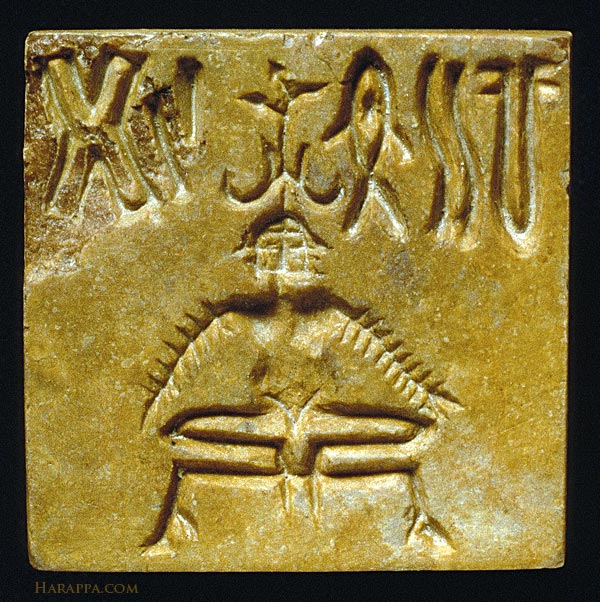
Types of Meditation
- Vipassana Meditation: Observing the sensations of the body to develop insight into the nature of reality.
- Transcendental Meditation: Using a mantra to quiet the mind and achieve relaxation and inner peace.
- Yoga Meditation: Practiced in conjunction with yoga postures and breathing exercises, focusing the mind on the breath or a particular point of concentration.
- Mindfulness Meditation: Bringing attention to the present moment and observing thoughts and emotions without judgment.
Major Schools of Meditation
- Self-Realization Fellowship Meditation: Founded by Paramahansa Yogananda, based on Kriya Yoga techniques.
- Transcendental Meditation (TM): Developed by Maharishi Mahesh Yogi, involves the use of a mantra.
- Kundalini Yoga and Meditation: Focuses on awakening the kundalini energy.
- Art of Living: Founded by Sri Sri Ravi Shankar, incorporates various meditation and yoga practices.
- Isha Yoga: Founded by Sadhguru Jaggi Vasudev, includes various yoga and meditation practices.
- Zen Meditation: A school of Mahayana Buddhism emphasizing meditation to achieve enlightenment.
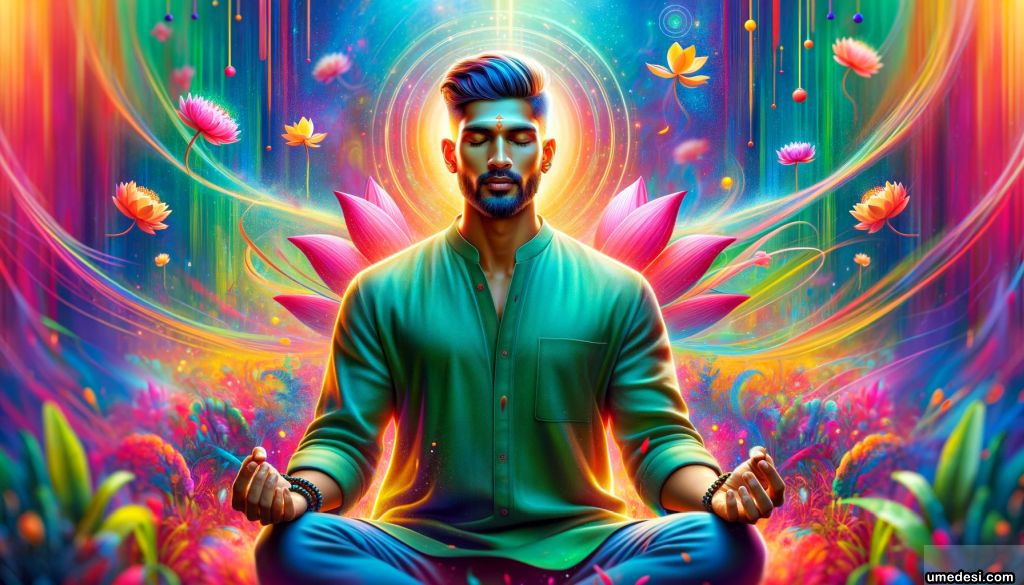
What is Mindfulness Meditation? It seems different in the class I took.
The Indian type of meditation that is considered the basis for mindfulness meditation used now everywhere is Vipassana meditation. Vipassana is a Pali word that means “insight” or “clear seeing”. It is a meditation technique that originated in India over 2,500 years ago and was taught by the Buddha himself.
Vipassana meditation involves observing the sensations of the body in order to develop insight into the nature of reality.
Mindfulness meditation, which is now used in many therapeutic settings and is a popular form of meditation practiced in the West, is based on the principles of Vipassana meditation.
It involves paying attention to the present moment without judgment, and cultivating an attitude of acceptance, kindness, and curiosity towards one’s experience.
This approach can help individuals to develop greater self-awareness, manage stress and anxiety, and improve their overall well-being.
Glossary of Indian Terms
- Adi Yogi: The first yogi, Lord Shiva, who is considered the originator of yoga.
- Asana: Physical postures practiced in yoga.
- Bhagavad Gita: A 700-verse Hindu scripture that is part of the Indian epic Mahabharata.
- Mudra: Hand gestures used in yoga to direct energy flow.
- Pranayama: Breath control techniques in yoga.
- Saptarishis: The seven sages who were the first disciples of Adi Yogi.
- Sanskrit: The ancient language in which many yoga texts are written.
- Shatkarmas: Cleansing practices in yoga.
- Swadharma: One’s own duty or role in life, prescribed by inherent qualities and social position.
- Yama: Moral codes in yoga practice.
- Yoga Sutras: A collection of aphorisms by Patanjali outlining the principles and practices of yoga.
Conclusion
Yoga, with its rich history and profound practices, continues to be a source of physical, mental, and spiritual well-being. By understanding its origins, various practices, and connection to meditation, practitioners can deepen their appreciation and experience of this ancient discipline.
The term Desi can refer to people of Indian subcontinent origin or ancestry, or it can refer to the cultural practices and products of the region.
Desi food, will include dishes such as biryani, Pongal, samosas, Dosa, Idli, Parantha, Chawal and dal, while Desi fashion may feature traditional clothing styles like sarees, salwar kameez, Dhoti, and kurta pajama.
Desi music may include traditional folk music (dozens of styles), classical music (also several distinct schools), traditional dance (several traditional and ancient styles) and popular movie or music genres like Bollywood, Tollywood, Kollywood, Mollywood (all different regional language film industry names – a play on the word Hollywood).
Use the Menu at the very top of this page to view many more articles.



